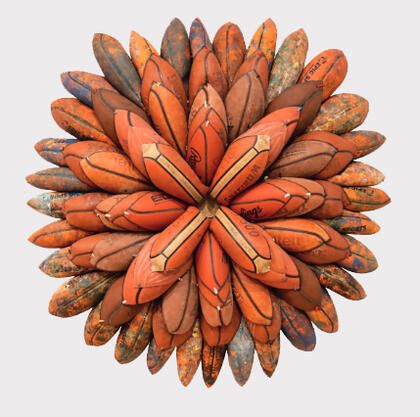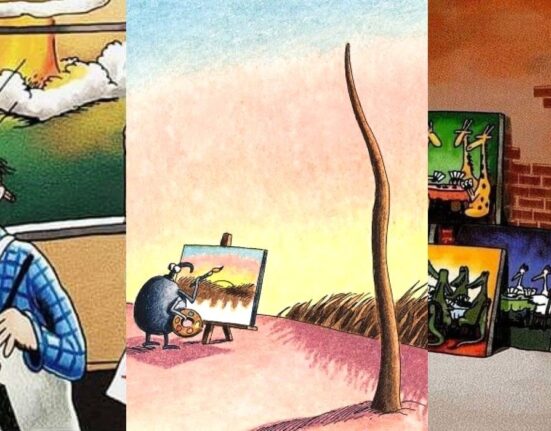What happens when basketballs become a work of art?
Such is the case with Baltimore-based artist Brandon Donahue-Shipp‘s Basketball Bloom (Spectrum), one of 10 new contemporary art pieces acquired this year by Johns Hopkins University. The acquisitions stem from an initiative launched in 2023 to collect and display art by local artists helping to shape contemporary art at the national and international levels. The initiative also aims to tap into and elevate the broad range of artistic talent in and around Baltimore and to deepen partnerships and programs that support the aspirations of—and economic opportunities for—individuals from local communities, a priority of the university’s Ten for One strategic vision.
“Contemporary art invites us to see the world around us in new and refreshing ways,” President Ron Daniels says. “We can’t wait to see these new pieces on display across our campuses, where they will bring people together and inspire conversations for decades to come.”
During the first round of acquisitions, Johns Hopkins purchased nine new works of contemporary art made primarily by Baltimore-based artists, including SHAN Wallace, Ernest Shaw Jr., Sebastian Martorana, Elena Volkova, LaToya Hobbs, and Linling Lu. The Johns Hopkins Art Collecting Committee, made up of a group of students, alumni, faculty, and staff, selected the artwork in collaboration with BmoreArt’s Connect + Collect. To make the final decisions, members of the committee visited and talked to artists in their studios, while seeing their art firsthand.
Before the 10 works of art purchased in the second round of acquisitions are installed across the university, they will be on view in Washington, D.C., at the Johns Hopkins Bloomberg Center‘s state-of-the-art exhibition space, the Irene and Richard Frary Gallery, which opened last year. There, the new pieces are displayed as part of an exhibition, Strong, Bright, Useful, and True: Recent Acquisitions and Contemporary Art from Baltimore, which opened on April 15 and runs through Aug. 16, 2025. The show features art not only from Johns Hopkins’ contemporary collection but also from the Baltimore Museum of Art. Highlights include works by bead and glass artist Joyce Scott, multimedia artist Derrick Adams, and painter Jerrell Gibbs, whose oil painting, Can’t Let ‘Em See Me Cry, is among the 10 pieces purchased this year that will eventually find a home somewhere on campus.
Here’s a look at the new art acquired and the talented individuals who created it.
Brandon Donahue-Shipp
Brandon Donahue-Shipp transforms found and discarded objects and materials into works of art that foster connections among communities and encourage viewers to consider the meaning imbued in the mundane items that surround us. Part of a series, Basketball Bloom (Spectrum) grew out of a youth event hosted by Donahue-Shipp at the Robert C. Marshall Recreation Center in West Baltimore. There, he used a favorite pastime, basketball, to nudge kids to harness their creativity and reflect on the overlap between sports and art. Participants covered basketballs with water-based inks, dribbled them on jersey-shaped pieces of a canvas-like cloth, and hung them around the gym for the community to see and enjoy. He then repurposed the ink-stained balls, plus an assortment of balls and shoestrings found throughout the city, to create the mandala-like Basketball Bloom (Spectrum). Seen out of context, the reconfigured basketballs and backstory encourage viewers to consider the meaning and value of sports in Baltimore communities.

Image caption:Basketball Bloom (Spectrum)
Image credit: Brandon Donahue-Shipp
Bria Sterling-Wilson
Photographer and collage artist Bria Sterling-Wilson culls and combines clippings from fabrics, old newspapers, Ebony and Jet magazines, family photographs, and other found materials to visualize and create new narratives about Black life, culture, and history. In What Do You Have to Lose?, a young woman embraces a young man, who stares off into distance, appearing worried or distressed. The closed door and brick wall depict the couple as pinned in, as though trapped by circumstances, while a fragment of an American flag—the only spots of color in an otherwise black-and-white collage—raises questions about the role of the United States. Is the flag a source of comfort or strife? What, exactly, does the couple have to lose—or hold onto—by their predicament? By providing clues but not disclosing the full story, Sterling-Wilson encourages viewers to discuss possibilities.

Image caption:What Do You Have to Lose?
Image credit: Bria Sterling-Wilson
Se Jong Cho
Se Jong Cho started painting as a doctoral student in environmental engineering and management at Johns Hopkins University. Now she works as a research hydrologist for the U.S. Geological Survey—and as a painter of otherworldly scenes fused with elements we know and recognize from our lives on Earth. Uranus Pool and Mercury Lounge both come from her series Modularity Space, a compilation of 11 surreal compositions that she refers to as “livingscapes.” In both paintings, curtains, tiled floors, and other remnants of human life float in space against a stark background. A celestial body illuminates the scene, much like a stage-light on a theatrical set. Inspired by a 1958 book, The Poetics of Space by French philosopher Gaston Bachelard, Cho says the process of painting helps her reclaim her childlike sense of wonder, swapping logic for imagination and embracing what could be, instead of what is.
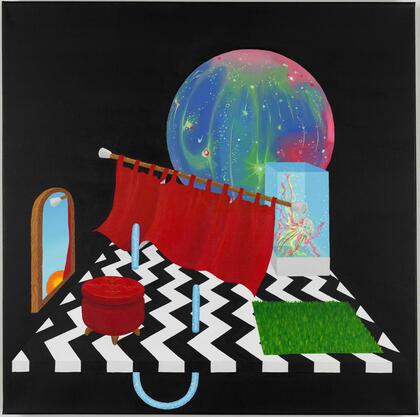
Image caption:Mercury Lounge
Image credit: Se Jong Cho
Erin Fostel
Erin Fostel‘s intricate charcoal drawings capture the all-too-ordinary parts of life that we often overlook or take for granted. In Untitled Window Series 20, a charcoal and graphite drawing on muslin, Fostel depicts a house plant she noticed in a windowsill during one of her long, routine walks around Baltimore. She took a photo of the plant, which she later used to produce Untitled Window Series 20. Here, she captures the sun’s unique dispersal of light on the plant’s twisting stems and leaves, while offering glimpses of both the interior space beyond the window and the exterior world reflected on the glass pane. The two spaces merge to create a sense of the surreal—and to serve as yet another example in Fostel’s work that art exists even in the most quotidian scenes.
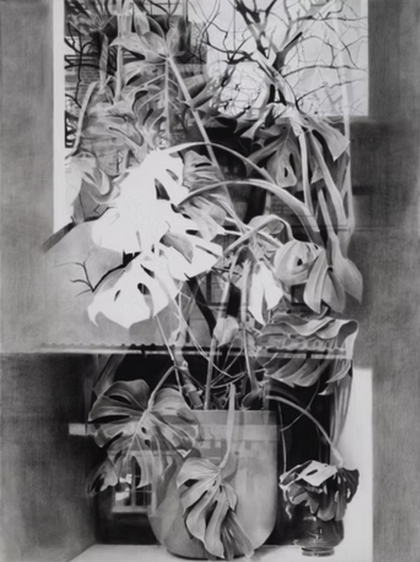
Image caption:Untitled window series 20
Image credit: Erin Fostel
Jerrell Gibbs
Jerrell Gibbs creates figurative paintings that evoke emotion and portray Black life, masculinity, and fatherhood in new, imaginative ways. An oil painter, Gibbs embraces the medium’s materiality by intentionally making his brushstrokes visible and building in textures that create a sense of movement and bring his scenes to life. In Can’t Let ‘Em See Me Cry, Gibbs explores societal expectations for Black men and boys, envisioning an emotional outburst in a safe place and challenging the harmful stigma that associates vulnerability with weakness.
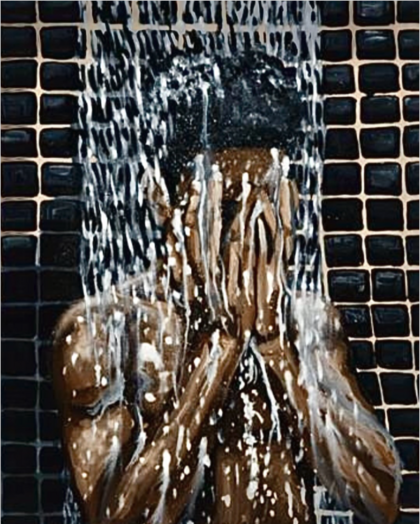
Image caption:Can’t Let ‘Em See Me Cry
Image credit: Jerrell Gibbs
Phaan Howng
Phaan Howng creates lush paintings and immersive installations that envision a post-human ecology in what she calls an “optimistic post-apocalypse.” In her paintings, dense vegetal matter appears to dominate the picture plane, obscuring what lurks behind but enticing viewers to contemplate. Inspired by short stories from Victorian botanical gothic literature, including those by H.G. Wells and Nathaniel Hawthorne, Howng’s paintings imbue plant life with an alien quality and serve as an example of dark humor. At the same time, embedded in her work, she says, is the idea that plants can create the façade of a healthy environment, while camouflaging colonialist legacies and the damage caused by humans to nature. Ultimately, Howng hopes her work encourages better ecological stewardship on Earth.

Image caption:Monstera Mash
Image credit: Phaan Howng
Kei Ito
Born in Japan, Kei Ito grew up hearing his grandfather tell stories of surviving the atomic bomb dropped on Hiroshima in 1945. Zen for a Dying Planet #2, part of a series, reflects the damage and destruction caused by nuclear warfare to both human life and the land on which we live. To create Zen for Dying Planet #2, Ito applied substances used by survivors to treat burns—honey, tree sap, and oils—to large photographic paper. From there, he used chemicals to transform the organic materials into sun-formed prints that evoke decaying landscapes and symbolize the pervasive effects of radiation. The resulting work of art aims to blur the lines between destruction and regeneration, while urging viewers to contemplate the scars left by nuclear warfare—and its lasting consequences on both bodies and land.
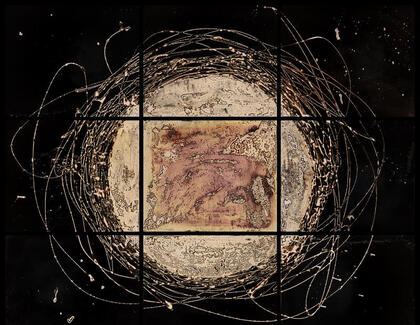
Image caption:Zen for Dying Planet #2
Image credit: Kei Ito
Edgar Reyes
Edgar Reyes explores the complexities of identity, memory, migration, and cultural heritage in largescale, multi-media murals, community projects, installations, and other art forms. He weaves in memories and experiences from his childhood and family in Mexico, a place where Indigenous and European cultures and roots intertwine—and a country far more complex than many people realize. In addition, he portrays the struggles he endured as an undocumented youth in the United States, along with the hardships his family confronted when torn apart by deportations. In Procession, Reyes features an old, black-and-white photograph of a religious procession held near Ixtlahuacán del Rio, outside of Guadalajara and close to his grandfather’s farm. Here, men carry a Virgin Mary statue and partake in a ritual that brings together the rural community, strengthens social bonds, and serves a devotional purpose that is also part of his heritage. The view of the procession is obscured, however, by a digital geometric pattern, which Reyes uses to signify both the fragmented nature of memory and the complexities of personal and national identity.

Image caption:Procession
Image credit: Edgar Reyes
René Treviño
René Treviño uses art to explore the subjective nature of history, attempting to shed light on the many perspectives and contextual details left out of historical textbooks. With Walls of the Yucatan, Treviño confronts an issue at the forefront of U.S. politics: walls and borders. He created the acrylic painting series from photographs taken on a trip to visit the ancient Mayan ruins of Chichen Itza, Coba, and Tulum in the Yucatan Peninsula. For each panel, Treviño used tiny paint brushes to reflect the many human hands involved in building the ruins. The rainbow of colors references both the pride flag and the grandeur of the Mayan Empire at its height, urging viewers to consider histories that have largely been untold—and the decision-makers involved in constructing walls and determining who does and does not gain access.

Image caption:Walls of the Yucatán (Carmine Red, Red Vermillion, Sahara Yellow, Veronese Green, Turquoise Blue, Ultramarine)
Image credit: René Treviño
For more information about the exhibition Strong, Bright, Useful, and True: Recent Acquisitions and Contemporary Art from Baltimore, visit the Irene and Richard Frary Gallery website.

